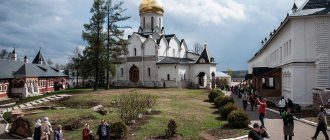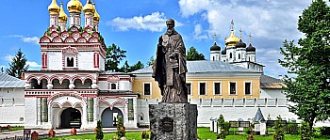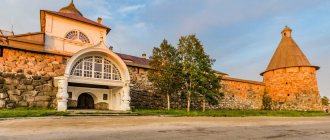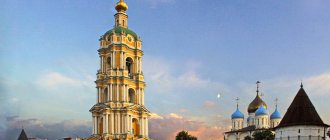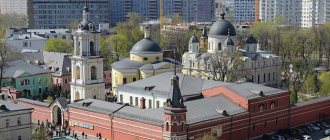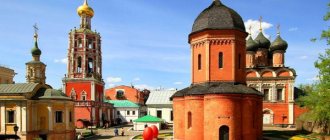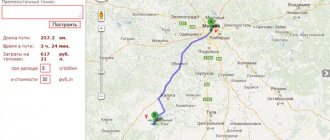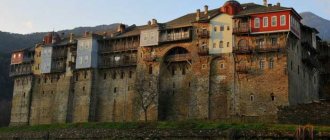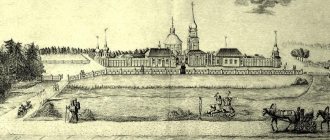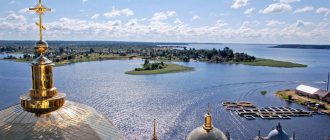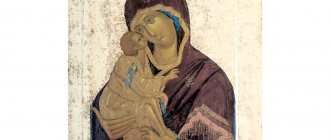History of the construction of the monastery
The first stone of the future shrine was laid in 1397. Its construction was preceded by the miraculous salvation of Moscow from the raid of Timur-Tamerlane. During the religious procession, the Vladimir Icon of the Most Holy Theotokos was encountered along the procession’s path, and the next day the enemy moved away. It was then that Prince Vasily I decided to build the Sretensky Monastery on Kuchkovo Field, the place where the miracle happened.
In 1922, the Lavra lost almost all of its church relics, and a little later it was officially recognized as Renovationist. Not long after this, Bishop Antonin served there, but a year later the monastery was transferred under patriarchal jurisdiction. A couple of years later (1926), the monastery was abolished, and the main church was made a parish church.
The end of the 20s of the 20th century became especially tragic for the Sretensky Skete. Then most of the buildings, including the Cathedral of St. Mary of Egypt, were dismantled to the ground, and church shrines were sent to museums. Those buildings that survived were occupied by NKVD officers, and executions were carried out on the territory of the monastery itself. The bodies of the victims were buried there, in the monastery graveyard.
Construction of the shrine began in 1397
Under Soviet rule, a school was built at the burial site, and until the 90s, the building of the Sretensky Church belonged to the All-Union Art Scientific and Restoration Center named after. Grabar.
At the beginning of 1991, the Church of the Presentation of the Vladimir Icon of the Virgin Mary was transferred to the Russian Orthodox Church, and a couple of years later (1993) a courtyard of the Pskov-Pechersk monastery was opened on the territory of the monastery. The monastery received the status of a stauropegic monastery only three years later (1996), at which time Abbot Tikhon became the rector of the monastery.
Official website of the Sretensky Monastery
https://www.pravoslavie.ru/
Address
Moscow, Bolshaya Lubyanka, 19
After the communists came to power, the Sretensky Monastery in Moscow for a long time remained a beacon of the Christian faith and, as best it could, fought against the implanted atheism. During the terrible years for Orthodox Christians, the ruler of the monastery was Archbishop Hilarion (Troitsky), a talented theologian and preacher, whose sad fate we reported above.
In the early 20s, the monastery was stripped of its relics, and then it was captured by “renovationists” - there was such a dubious church association. Bishop Antonin (Granovsky) managed the monastery for a year, then, thanks to the efforts of the Hieromartyr Hilarion, they managed to return it under the wing of the Orthodox Church, but not for long - in 1926 the Sretensky Monastery was closed. Almost all of its structures were razed to the ground “to expand street traffic.” Church objects and icons, which the communists did not manage to nationalize, received their new registration in museums and cultural organizations. For example, the icon “The Exaltation of the Cross,” which dates back to the 18th century, is still listed in the collection of the Tretyakov Gallery to this day.
In the 20th century, a hostel was built on the monastery lands for NKVD employees, who shot hundreds of people right in the monastery. To honor the memory of the victims of Soviet tyranny and as a bitter reminder, a worship cross was erected at the monastery in the 90s.
The power of the “workers and peasants” did not spare the cemetery at the monastery, where participants in the war with Napoleon found their rest. In its place a secondary school appeared - studying on the bones of heroes. For a long time, the Sretensky Cathedral housed a scientific and restoration center named after. I.E. Grabar. In the early 90s, the temple became operational again. Later, with private funds, the fence and belfry were re-erected, their style reminiscent of the architecture of the 17th century. In 1996, the Sretensky stauropegic monastery opened a new page in its chronicle.
Over the past years, the Moscow monastery has been revived - restoration was carried out, several buildings were built for monks (there are now about 40 of them), the Sretensky Theological Seminary was opened, the students of which are seriously involved in the affairs of the monastery - they live in the monastery, take part in liturgies, and perform obediences.
The Sretensky Monastery carries out extensive educational work - one of the largest Orthodox publishing houses operates on its lands, and the Pravoslavie.Ru portal is maintained. A center for the study of the Shroud of Turin has been established at the monastery. The choir of the Sretensky Monastery deserves special mention. He is considered the leader of the Orthodox Church and sings at large services, and also performs in concerts around the world.
Monasteries
The monastery is run by two monasteries. One, named after St. Seraphim of Sarov, is located on the site of the Krasnoe estate restored by the brethren in the Ryazan region. The monks' settlement looks like a round fortress, where there is a church, fraternal cells, an apiary, garden beds, a pond, and a barnyard.
There, in the Ryazan region, in Mikhailov, the monastery takes care of a local orphanage, the director of which is a priest - a graduate of Sretensky Seminary.
Another, women's, monastery in the name of the prophet Elijah is located in the Moscow region.
Shrines
The monastery contains: a list of the holy image of the Vladimir Mother of God, the relics of the Hieromartyr Hilarion and other saints, a detailed copy of the Shroud of Turin, an icon of St. Seraphim of Sarov with a particle of his relics.
Architecture in the Sretensky Monastery
The temple in its original form has not survived to this day. Today you can see only a few buildings that have survived such a long history. The entire composition is quite monumental and distinguished by its laconic lines.
Dismantled temples
The Cathedral of St. Mary of Egypt was built in 1385. A century later, the wooden walls were replaced with stone ones. The church was a small rectangular building with one dome. By the beginning of the 18th century, it was replenished with the chapel of the Presentation of Christ, and 20 years later the temple was closed. It began to operate again only 40 years later, when Afanasy Goncharov took up the reconstruction. The building was completely dismantled already in the 30s of the 20th century.
Another church, also dismantled at the beginning of the 20th century, is Nikolskaya. The stone building of the second half of the 17th century retained its shape until its dismantling. The cathedral was distinguished by cross-shaped vaults and keel-shaped kokoshniks that decorated the upper part of the building. After the fire of 1737, the temple was rebuilt, and a chapel in the name of All Saints appeared inside.
Along with the St. Nicholas Church, the gate bell tower, erected in the 70s of the 17th century, was also dismantled. After the temple was damaged by fire, the belfry was rebuilt by Ivan Michurin, and its dome was replaced with a baroque one.
Currently, the domes that previously crowned the bell tower of the Sretensky Monastery decorate the belfry of Harvard University in the USA.
Modern buildings
One of the buildings that has survived to this day is the Church of the Presentation of the Vladimir Icon of the Mother of God (1679). In 1706, he acquired a chapel of John the Baptist, and by the beginning of the 21st century, a chapel in the name of St. Mary of Egypt.
On the territory of the monastery there is a temple of the Presentation of the Vladimir Icon of the Mother of God
The architecture of the five-domed cathedral belongs to the Moscow-Yaroslavl style. The building itself is square, two-pillared with three naves. The wall paintings were done by Kostroma masters of the early 18th century. The lower floor of the temple is known for its crypt with the chapel of the Resurrection of the Lord. It is decorated with white marble, and mosaic painting depicts the symbolism of ancient Christian churches.
The Cathedral of the New Martyrs and Confessors of Russia is a large building about 60 meters high with seven golden domes. The architecture is dominated by Russian style with Byzantine elements. The baptistery is located near the lower church, and most of the complex is occupied by a museum along with administrative and office premises. Today there are also two churches at the monastery: St. John of Kronstadt and in the name of the Holy Life-Giving Trinity.
There is also a Theological Seminary on the territory of the Sretensky Lavra, and since 2012, the premises previously occupied by the All-Russian Musical Society (Rozhdestvensky Boulevard) have been transferred to the monastery.
Russian Orthodox Church
Story
Founded in 1397 at the meeting place of the miraculous Vladimir Icon of the Mother of God in memory of the deliverance of Moscow from the invasion of Tamerlane. The main church was rebuilt in 1677 and consecrated in the name of the Presentation of the Vladimir Icon of the Mother of God, and a chapel of the Nativity of John the Baptist was added to the southeast. The frescoes are well preserved - the last masterpiece of ancient Russian art in Moscow (1707). During the celebration of the Presentation of the Vladimir Icon of the Mother of God, annual religious processions were held from the Assumption Cathedral of the Kremlin to the monastery.
Sretensky Monastery played an active role in the election of Mikhail Feodorovich, the first king of the Romanov dynasty, to the kingdom. Almost every pilgrimage of kings, patriarchs, metropolitans, princes, and ordinary pilgrims always began with prayers at the Sretensky Monastery. In the 19th century, the primate cathedra was temporarily located in the Sretensky Monastery.
After the October Revolution of 1917, the Sretensky Monastery became one of the main centers of the struggle against the godless authorities for Orthodoxy. The rector of the monastery in those years was the associate of His Holiness Patriarch Tikhon, Sschmch. Archbishop Hilarion (Troitsky), an outstanding theologian and preacher. In 1922, the Sretensky Monastery was captured by the “renovationists,” but through the efforts of the Hieromartyr Hilarion in 1923, the monastery was returned to the Orthodox Church, and its cathedral was reconsecrated with a great rite.
On December 4, 1925, Sergei Izvekov, the future Patriarch of Moscow and All Rus' Pimen, took monastic vows here.
At the end of 1925, the Sretensky Monastery was closed. In 1928-1930 Most of the temples and buildings of the monastery were destroyed. Soon a dormitory for NKVD officers was located here. Executions were carried out on the monastery territory adjacent to the buildings of the country's main Cheka. This piece of land is literally soaked in the blood of thousands of new martyrs of the terrible era of persecution of the Church. In memory of all the victims of the atheistic government, a worship cross was installed at the entrance to the monastery in 1995, consecrated by His Holiness Patriarch Alexy II.
Before the revolution, there was also a cemetery on the territory of the monastery, where participants in the Patriotic War of 1812 were buried. In Soviet times, a secondary school building was built on the site of the graveyard.
In 1991, the preserved Cathedral of the Vladimir Icon of the Mother of God was returned to the Church and opened as a parish church. In 1993, the courtyard of the Pskov-Pechersky Monastery was opened, in 1995 it was transformed into the Sretensky Stavropegic Monastery.
On May 9-10, 1999, the glorification of the Sschmch took place in the monastery. Hilarion, Bishop of Verei (†1929).
A bell tower was erected, the ancient monastery premises were restored, two new five-story buildings were built and one four-story building was rebuilt, where the brethren of the monastery and the Sretensky Theological Seminary were located. Nowadays more than forty monks live and work in the Sretensky Monastery. The monastery organizes catechetical courses, which are attended mainly by people who have recently entered church life. Currently, about four hundred people are enrolled in the courses.
Sretensky book publishing house is one of the largest in modern Russia. The publishing house publishes liturgical, theological, historical, fiction, and books on all major areas of religious life.
The Sretensky Monastery also has two monasteries: male and female. The first, in the name of St. Seraphim of Sarov, is located in the Ryazan region. The second monastery, in the name of the prophet of God Elijah, is located in the Moscow region. The brethren of the monastery make regular trips to Chechnya to provide spiritual and material assistance to Russian soldiers and local residents. The Sretensk Higher Orthodox Monastic School, the Russian Center for the Study of the Shroud of Turin, a Sunday school, a publishing house and the online magazine Pravoslavie.ru operate at the monastery. Under the patronage of the Sretensky Monastery, the Resurrection collective farm is being restored. In 2003, the Resurrection cooperative received the state Stolypin Prize as “the most efficient land user in Russia.”
Temples
Cathedral of the Presentation of the Vladimir Icon of the Mother of God with the chapel of the Nativity of John the Baptist (1677). Church of the Resurrection of Christ and New Martyrs and Confessors of the Russian Church (2017).
Temple of St. Mary of Egypt (1385, renewed in 1784, now defunct). Church of St. Nicholas (no longer exists).
Shrines
The relics of the schmch. Hilarion (Trinity), an icon with a particle of the relics of St. Seraphim of Sarov, an exact copy of the Shroud of Turin in life size (negative and positive), a revered copy of the Vladimir Icon of the Mother of God.
Viceroys
- 1995-2018 — Eminence Tikhon (Shevkunov)
- from May 19, 2018 to August 30, 2021 - Hieromonk John (Ludishchev) (acting vicar)
- from August 30, 2021 to August 25, 2021 - Archbishop Ambrose of Vereya
- from August 25, 2021 - Hieromonk John (Ludishchev)
Abbots and shrines of the holy monastery
From the moment the monastery was transferred to the Russian Orthodox Church and until 2018, Tikhon (Shevkunov) was the rector of the monastery. Since May, John (Ludishchev) became the abbot of the monastery.
Sretensky Lavra has always attracted pilgrims from all over Russia. Believers never stop coming here to venerate such shrines:
- an accurate list of the Shroud of Turin (life-size);
- copies of the Vladimir Icon of the Blessed Virgin Mary;
- relics of the Great Martyr Hilarion.
Also here are pieces of the relics of St. Mary of Egypt, Nicholas the Wonderworker, John Chrysostom, Seraphim of Sarov and other saints.
Life-size replica of the Shroud of Turin
Copy of the Vladimir Icon of the Blessed Virgin Mary
Relics of the Great Martyr Hilarion
Schedule of services at Sretensky Monastery
Getting to the famous men's monastery is not difficult. It is located at the address: Moscow, Bolshaya Lubyanka, building 19, building 1.
The Lavra is open to pilgrims every day. All services are held strictly according to the schedule in Church Slavonic:
- Liturgy – 8:00 (weekdays), 7:00 and 10:00 (weekends, holidays);
- Midnight Office – 6:30;
- Vespers – 18:00;
- Akathist to the Virgin Mary - on Friday evenings.
Changes in services or a detailed schedule for the current week can be found on the official website.
The monastery is open daily for pilgrims.
The monastery also celebrates patronal holidays:
- February 15 – Presentation of the Lord;
- April 9 and 14 – celebration in the name of Mary of Egypt;
- May 22 and December 19 – transfer of the relics of St. Nicholas the Wonderworker;
- June 3 – deliverance from the invasion of Makhmet-Girey;
- July 6 – miraculous rescue from Khan Akhmat;
- September 8 – transfer of the Vladimir Icon of the Mother of God;
- November 3 – celebration of St. Hilarion.
Despite its dramatic history, the Sretensky Monastery still continues to play a great educational role. A theological seminary has been opened on its territory, there is its own choir, one of the publishing houses of the Russian Orthodox Church operates, and its own Internet portal has also been opened.
If you find an error, please select a piece of text and press Ctrl+Enter.
Get to the monastery. Closed area near Mikhailov
Probably, the opportunity to visit the monastery in the Mikhailovsky district of the Ryazan region would not have aroused such burning interest in me if it had been said in advance that it was supposedly closed. And that it is supposedly impossible to enter its territory. Not only rumors, but also Internet publications authored by amateur tourists were full of strange information about the unfriendliness of the inhabitants of the monastery, about guards with weapons, angry dogs on chains and insurmountable fences.
Getting into the territory legally has become a sort of sporting interest. Who would have thought that getting into it would actually be much easier than it is portrayed on the Internet. Correspondent of the Business portal YA62.ru
I visited the monastery and didn’t even have to climb over the fence.
The secret of the open doors of the monastery is very simple, and therefore I will not put off exposing it until the end: it turns out that it is enough to simply arrange an excursion in advance, through, say, the representative office of the Ryazan diocese. Which is exactly what we did. They were sincerely glad to see us and even gave us a tour so that those from outside who wanted to visit the monastery would not wander around the territory.
The pseudo-Gothic Krasnoye estate, which has recently been in the possession of the monastery courtyard, belonged to the favorite of Catherine the Great, Alexander Ermolov, in the 18th century. Thanks to the empress’s rich salary, received “by chance,” Ermolov in 1785 began rebuilding the family estate. And a year later, the Church of Our Lady of Kazan was founded, on the pediment of which there is an inscription “from the generosity of the great Catherine.”
“During the Soviet era, the temple was looted, like many others,” said our guide, a servant of the monastery. — Believers tried to preserve some of the most valuable things and hide them in their homes. But not everyone treated icons and other church relics with the same care. A local resident covered a vat of sauerkraut with one of the central icons of the temple, using it as a press. And she kept wondering why her family was haunted by troubles? When there was a fire in her house, one of the neighbors managed to take out the icon. And immediately behind him the house collapsed under fire.
The estate in Krasnoye consists of an English landscape park with flowing ponds and dams, as well as a huge territory, part of which the monks now use for subsistence farming. It is difficult to cultivate these lands manually, and it is not necessary, so in addition to the garden, flower beds and vegetable garden, you can find sheep in the dandelion fields.
As in any estate, Krasnoye has a two-story manor house with rounded vestibules and lancet windows. It, for obvious reasons, was built on a hill. The low ground floor was occupied by household services. In the mezzanine, before the revolution, Catherine’s room was preserved, where the Empress herself supposedly stayed. After the revolution, the house was looted and destroyed. Restoration of the estate began only in the 2000s.
In 2000, at the request of the patriarch, the estate with all the buildings and a large landscape park was transferred to the ownership of the Sretensky Monastery. Then a long period of restoration of the country’s architectural heritage began. Now all the buildings have been restored; they house a monastery courtyard with the St. Seraphim monastery and an orphanage nearby. In the manor house there are premises for common needs - a refectory, halls for communication of seminarians, as well as the residence of the patriarch.
The most original building of the estate can be called a barnyard, standing on an artificial peninsula and “disguised” as a miniature fortress with four elegant turrets. The similarity of the white stone gear-lancet decoration with Bazhenov’s buildings in Tsaritsino near Moscow prompted local historians to hypothesize that the architect Bazhenov himself was involved in the design.
Nowadays there are cells in the barnyard building. Along the road from the main estate to the farmyard, guest houses have been built where tourists can stay overnight. If, of course, they warn the staff of the monastery in advance.
The Krasnoye estate is a place where you don’t want to rush. It’s as if time stood still back in 1785, and you wander through the emerald grass and admire how beautifully they used to build. The only thing that brings us back to modern reality is our monk-tour guide, who told jokes to tourists and happily took selfies with them. So it’s difficult to call the monks of the monastery hermits. And the rumor that they do not want to allow travelers into the estate will remain a myth passed on from mouth to mouth.
More photos HERE
Daria <I'll go to a monastery> Koposova
Photo by Maria Illarionova
